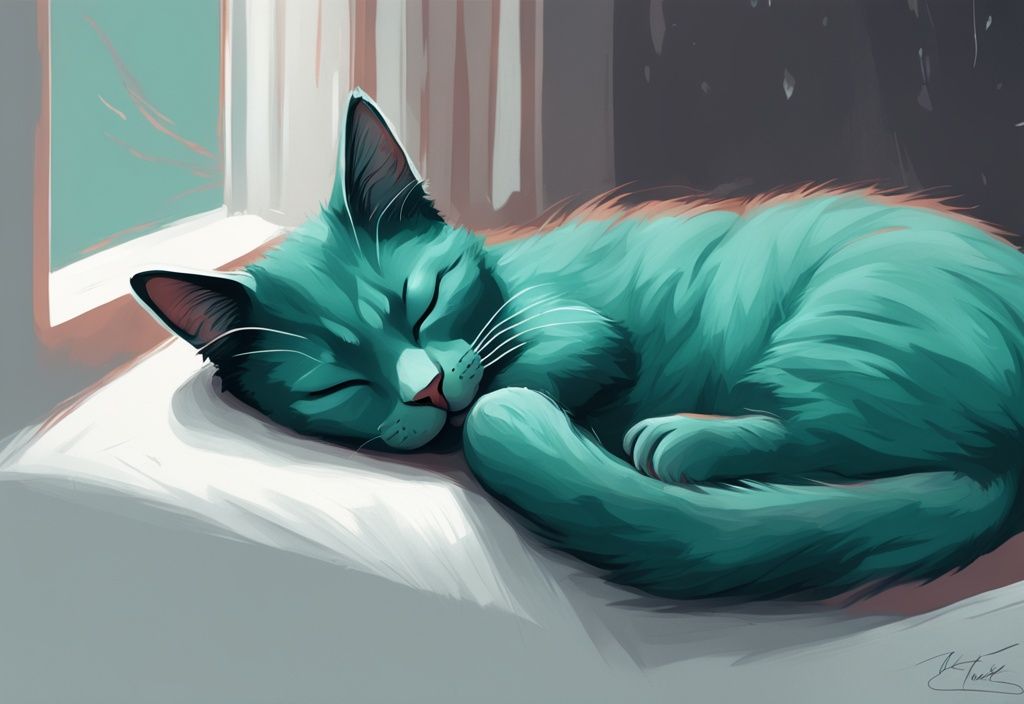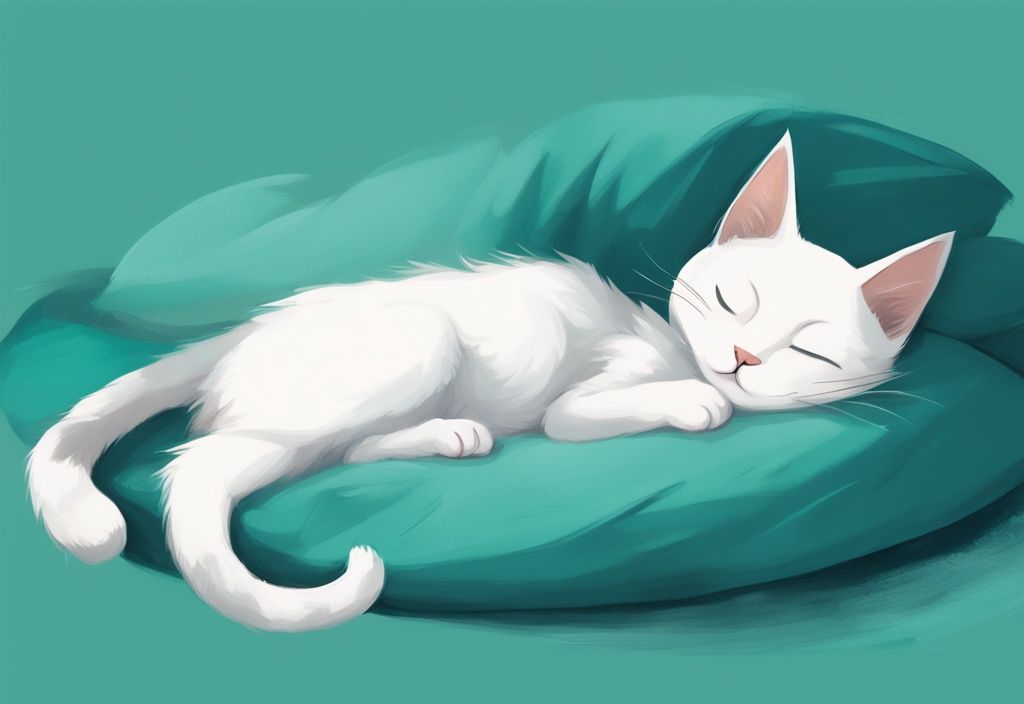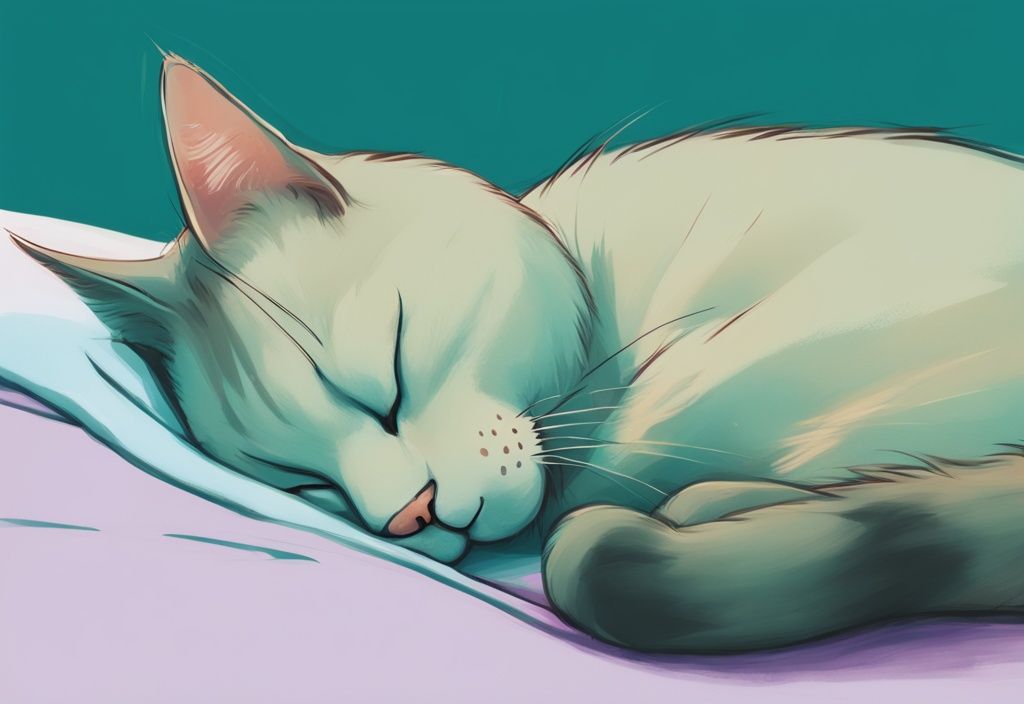Picture this: your feline friend, much like my cuddly rescue cat Whiskers, is nestled in their favorite spot, eyes closed, whiskers twitching, and paws paddling the air. It’s a scene that many cat owners find both endearing and puzzling. Why do cats twitch in their sleep, and should you be concerned?
Cats, much like us and my playful Border Collie Max, experience various stages of sleep, including REM sleep, where dreaming occurs. During this phase, twitching is often a normal part of their slumber. However, distinguishing between normal twitching and signs of a potential health issue can be challenging.
This article delves into the fascinating world of feline sleep behaviors, providing insights into what constitutes normal twitching and when it might be a cause for concern. We’ll explore common twitching behaviors, potential health issues, and preventive measures to ensure your cat’s well-being. Whether you’re a seasoned cat owner or new to the joys of feline companionship, understanding these behaviors can help you provide the best care for your furry friend.
Understanding Your Cat’s Sleep Twitching
Ever found yourself watching your cat twitching away in dreamland and wondered if it’s normal? Let’s dive into the fascinating world of feline sleep twitching and when you might need to pay closer attention.
Normal Sleep Twitching vs. Cause for Concern
Cats, just like us, journey through different sleep stages, including the mysterious REM (Rapid Eye Movement) sleep. During this phase, your furry friend might twitch as if they’re dreaming of grand adventures—perhaps chasing a mouse or exploring a new corner of the house. This is normal! These gentle, irregular movements are usually harmless and part of their dreamscape. You might notice relaxed breathing and a cat that can be easily woken. It’s a sign that your feline is processing their daily escapades. Recognizing these natural behaviors is key to distinguishing between normal twitching and when something might be amiss.
Common Twitching Behaviors
During REM sleep, you might spot your cat’s paws, whiskers, ears, legs, or tail doing a little dance. Sometimes, these twitches come with a soft meow or a purr, adding to the cuteness overload. Kittens are particularly twitchy sleepers, which is fantastic for their brain and motor development. It’s like a mini workout that helps them grow into agile adults. The twitching can range from subtle paw flicks to more dramatic full-body wiggles. Watching these antics can give you a peek into your cat’s sleep patterns and overall health.
When Should You Worry About Your Cat’s Twitching?
Sometimes, our furry friends twitch in their sleep, and it’s perfectly normal. But how do you know when to be concerned? Let’s dive into the signs that might need a closer look.

Distinguishing Between Normal and Abnormal Twitching
Understanding why your cat is twitching in his sleep can feel a bit like detective work, but don’t worry—it’s easier than it sounds! Normal twitching is usually sporadic, with your kitty breathing softly and waking up easily. It’s all part of their dreamy REM sleep. But if your cat’s twitching is more like a dance marathon, it might be time to pay attention.
Think of it this way: if Whiskers, my cuddly rescue cat, started twitching non-stop, I’d be on high alert. Could it be a neurological issue, or maybe he’s gotten into something he shouldn’t have? Stress, medication, or even toxins can cause abnormal twitching. Keep an eye out for patterns or changes in behavior—your cat’s health might just depend on it!
Signs of Possible Health Issues
If your cat’s twitching is happening both during those cozy naps and when they’re wide awake, it could be a red flag. Look out for other symptoms like a sudden loss of appetite, changes in behavior, or even difficulty walking. These could be signs that it’s time for a vet visit.
Sleep seizures are a bit like a dramatic movie scene—intense, rhythmic jerking, stiff limbs, drooling, and sometimes even vocalizations. If you notice these, it’s a cue to seek immediate veterinary care. By keeping a watchful eye, you can ensure your cat stays healthy and happy. After all, our pets rely on us to be their health advocates, and a little vigilance goes a long way!
Health Issues That Cause Twitching in Sleep
Ever wondered why your cat might twitch in their dreams? It could be more than just chasing imaginary mice. Let’s dive into some possible health issues behind this curious behavior.
Neurological Disorders
Ah, the mysterious world of feline neurology! Neurological disorders can sneak into your cat’s sleep, causing twitching that seems more like a dance. Conditions like epilepsy or other imbalances might be the culprits. If Whiskers is twitching more than usual, it might be time to call the vet. Catching these issues early can make all the difference in keeping your kitty comfy and healthy.
The Impact of Toxins and Medications
Did Whiskers nibble on something they shouldn’t have? Toxins lurking in plants, chemicals, or even some human treats can mess with their nervous system, leading to twitchy dreams. And let’s not forget about medications—sometimes they come with a side of twitching. If you suspect something’s amiss, a quick chat with your vet can help clear things up. Better safe than sorry, right?
Understanding Sleep Seizures
Now, if the twitching turns into a full-blown sleep seizure, that’s a different ball game. Picture rhythmic jerking, stiff limbs, maybe even drooling or vocalizing. It’s like Whiskers is in a deep dream they can’t wake from. These seizures can signal deeper health issues, so a prompt vet visit is a must to keep your feline friend safe and sound.

Feline Hyperesthesia Syndrome
Here’s a quirky one—Feline Hyperesthesia Syndrome! While it usually strikes when cats are awake, it can cause some twitching. It’s like your cat’s senses are on high alert, leading to sudden bursts of activity. Although it doesn’t typically disrupt sleep, it’s good to know about. If Whiskers starts acting a bit odd, whether snoozing or playing, a vet visit can offer peace of mind. After all, a happy cat makes for a happy home!
Preventive Measures for Abnormal Twitching
Creating a Comfortable Sleep Environment
Imagine your cat nestled in a soft, cozy bed, tucked away in a quiet corner of your home. Sounds dreamy, right? Cats, much like us, thrive in peaceful environments. Providing a serene spot free from disturbances can work wonders for their sleep quality. A comfy bed away from the hustle and bustle not only promotes restful slumber but also helps reduce stress, a sneaky culprit behind excessive twitching. And hey, why not establish a stable routine with consistent sleep times? It’s like a lullaby for reducing anxiety-related twitching.
Importance of Regular Vet Check-Ups
Picture this: a vet visit as a friendly chat about your cat’s well-being. Regular check-ups aren’t just about shots and scales; they’re your golden ticket to catching any potential health hiccups early. Chat with your vet about any quirky sleep patterns or twitching episodes your cat might be experiencing. Early detection is like finding a four-leaf clover—it leads to effective treatments and keeps serious health issues at bay. Your vet is a treasure trove of insights and might suggest specific tests if there’s an underlying cause. Keeping the conversation open ensures your feline friend gets top-notch care.
Monitoring and Recording Twitching Patterns
Ever played detective? Well, keeping tabs on your cat’s twitching patterns is a bit like that. Note how often, how long, and how intense these twitching episodes are. If you spot anything unusual or if the twitching comes with other symptoms, it might be a clue to a health issue. Recording these episodes, maybe even capturing a video or two, can be a game-changer for your vet. This proactive approach is like having a crystal ball, allowing for timely interventions to keep your cat healthy and purring.
FAQ
Ever wondered why your cat twitches in his sleep? Let’s dive into some common questions about this quirky feline behavior!
Is it normal for cats to twitch in their sleep?
Absolutely! Cats twitching in their sleep is as normal as Max chasing his tail. This twitching often means your kitty is dreaming, with high brain activity during REM sleep. It’s a natural part of their snooze cycle, so no need to worry.

What should I do if my cat’s twitching seems excessive?
If your cat’s twitching looks more like a dance party than a nap, it might be time to call the vet. Excessive or continuous twitching can sometimes point to health issues. Catching these early can make all the difference!
Can stress cause my cat to twitch in his sleep?
Oh, stress! Just like us, cats can twitch more if they’re stressed. Creating a calm, cozy environment can help your feline friend relax and reduce those stress-induced twitches.
How can I tell if my cat is having a seizure while sleeping?
Seizures during sleep are a bit different. Look for intense, rhythmic jerking, stiff limbs, drooling, and vocalizations. If Whiskers seems stuck in a dream and can’t wake up, it’s time for a vet visit. Quick action is key!
Conclusion
Why is my cat twitching in his sleep? It’s a question that might have you scratching your head while watching your feline friend doze off. Understanding this quirky behavior is key to ensuring your kitty’s well-being.
Most of the time, twitching during sleep is perfectly normal. It’s often linked to dreaming and high brain activity, much like when we humans have vivid dreams. Cats go through different sleep stages, and twitching is most common during REM sleep, which is when they’re likely chasing imaginary mice or batting at phantom strings in their dreams.
But, just like with my Border Collie, Max, who sometimes barks in his sleep, it’s important to keep an eye on things. If you notice a change in the frequency or intensity of the twitching, or if it’s paired with other symptoms like changes in behavior, appetite, or mobility, it might be time to consult your vet.
Keeping an eye on your cat’s sleep patterns can offer valuable insights into their health. Regular vet check-ups are like a spa day for your pet’s health, catching any potential issues before they become big problems. By knowing the difference between normal twitching and signs of potential health concerns, you can take proactive steps to ensure your cat’s comfort and health.
Creating a cozy sleep environment can also do wonders. Think of it as setting the stage for a purr-fect night’s sleep—calm, comfortable, and stress-free. Remember, your care and attention play a big role in your cat’s happiness and health. After all, isn’t it a joy to see them snooze peacefully, knowing they’re safe and sound?
